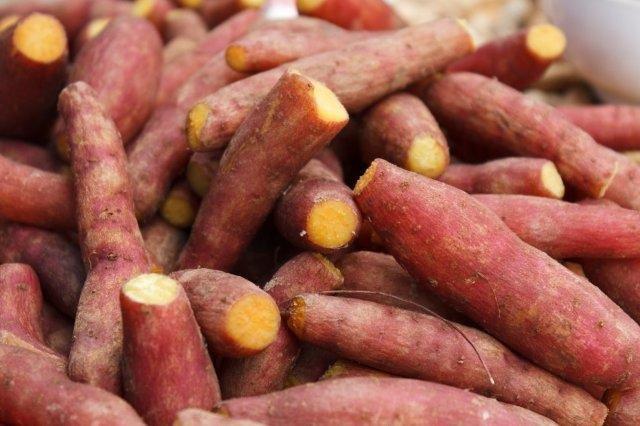EMBARGOED FOR RELEASE | September 08, 2013
Purple sweet potatoes among ‘new naturals’ for food and beverage colors
Note to journalists: Please report that this research was presented at a meeting of the American Chemical Society.
A press conference on this topic will be held Sunday, Sept. 8, at 9:30 a.m. in the ACS Press Center, Room 211, in the Indiana Convention Center. Reporters can attend in person or access live video of the event and ask questions at www.ustream.tv/channel/acslive.
INDIANAPOLIS, Sept. 8, 2013 — Mention purple sweet potatoes, black carrots or purple carrots, and people think of dining on heirloom or boutique veggies. But those plants and others have quietly become sources of a new generation of natural food colorings that are replacing traditional synthetic colors and colors derived from beetles.
That back-to-the-future trend is on the agenda here today at the 246th National Meeting & Exposition of the American Chemical Society (ACS), the world’s largest scientific society. The meeting, which features almost 7,000 reports on new discoveries in science and other topics, continues through Thursday in the Indiana Convention Center and downtown hotels.
Speakers described how natural colors used centuries ago are making a resurgence in response to consumer preferences, manufacturers’ needs and the promise that these antioxidant-rich substances may have health benefits.
“The natural colors industry for foods and beverages is gaining in value as U.S. and international companies move towards sustainable and affordable crop alternatives to synthetic red colors and red colors derived from insects,” explained Stephen T. Talcott, Ph.D., who spoke at the session. “In addition to adding eye appeal to foods and beverages, natural colorings add natural plant-based antioxidant compounds that may have a beneficial effect on health.”
One major change, he said, is the appearance of root crops like black carrots and purple sweet potatoes (PSPs), which are grown specifically for the natural colors industry. They have become primary agricultural products, compared to fruits such as grapes, which are grown for other purposes and used as secondary or byproduct-based colors.
Talcott, who is with Texas A&M University, focused on the range of colors — from light pink to rose, red and deep purple — that can be obtained through use of the pigments in PSPs. Available commercially in the United States since 2006, but still hard to find in stores, PSPs have the same anthocyanin pigments found in black cherries. Baked, used for french fries or prepared in other ways, PSPs taste like regular sweet potatoes, Talcott noted.
PSP anthocyanins have proven to be among the best for food and beverage coloring, he said, citing fruit drinks, vitamin waters, ice cream and yogurt. They are stable, for instance, and do not break down easily; have superior coloring properties; and have a relatively neutral taste (in contrast to the slightly earthy, bitter taste from grape-based colorings). The pigments, however, are very difficult to extract.
Likewise, PSP anthocyanins have advantages over traditional synthetic red food colorings and the “carmine” reds extracted from cochineal insects. Those include sustainability and ease of production. Cochineal insects feed on a certain type of cactus native to South America and Mexico. It takes about 2,500 bugs to produce one ounce of cochineal extract, used in ice creams, yogurts, candy, beverages and other foods.
However, PSP anthocyanins are difficult to extract. Talcott reported on development of a new process that extracts larger amounts of pigment from PSPs. Byproducts of the process include starch and fiber, which could be used as animal feed, in various food applications or as a raw material for biofuel production. Alternatively, the byproducts could simply be composted and used as a soil conditioner for producing more PSPs or other crops.
Such processes could encourage development of a domestic natural food coloring industry, with agriculture spreads devoted specifically to growing foods for use in making food and beverage coloring. Currently, the United States imports much of the natural food coloring it uses commercially. The small amounts of PSPs grown domestically go mainly to sales of fresh potatoes for the table.
Talcott spoke at a symposium, “The Chemistry of Functional Beverages,” which are beverages that go beyond the basics of quenching thirst or providing nutrition: They prevent disease or promote general good health. Abstracts for the symposium appear below.
To automatically receive news releases from the American Chemical Society, contact newsroom@acs.org.
# # #
The American Chemical Society is a nonprofit organization chartered by the U.S. Congress. With more than 163,000 members, ACS is the world's largest scientific society and a global leader in providing access to chemistry-related research through its multiple databases, peer-reviewed journals and scientific conferences. Its main offices are in Washington, D.C., and Columbus, Ohio.
Media Contact
During the national meeting, Sept. 6-11, the contacts can be reached at 317-262-5907.
Michael Bernstein
m_bernstein@acs.org
202-872-6042
Michael Woods
m_woods@acs.org
202-872-6293






